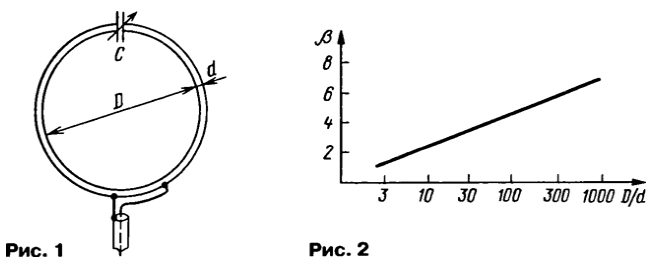Small loop antenna for many years to arouse the interest of radio Amateurs. In recent commercially available antennas, remotely configurable via KPE motorized.
It is well known that the quality factor Q is small (compared to wavelength (X) of the frame high, and therefore the bandwidth 2Δf = f 0/Q is not more than a few percent of its resonant frequency f 0. About the same efficiency (COP) of the framework go or legends, or completely inaccurate information.
In Amateur conditions is easy to make loop antenna to configure it the desired frequency f 0 and to coordinate with the feeder. Easy to identify and strip bandwidth 2Δf, at least in ascending order of module input resistance 1.4 times when on the detuning Δf. The CWS in the feeder varies from unity at the frequency f 0 up to approximately 2.6 at frequencies f 0 ± Δf. It turns out that these data are quite enough to assess the effectiveness of the constructed loop antenna, the size which, of course, also known Let's get together with the author will derive a few simple formulas that will allow to estimate efficiency. If someone doesn't like mathematics, he can just see the end of the article with conclusions and results. I hope they will not seem difficult (hi).
So, we will focus on the "round" frame with perimeter p = πD , significantly lower λ/2 (Fig. 1). The inductance of the frame compensated by the capacitance of the capacitor C, thus, the antenna is tuned to resonance, and its resistance becomes purely resistive and equal to R∑ + Rn, where R∑ - radiation resistance; Rn - resistance losses. When this is installed in the frame ring current the maximum amplitude with almost uniform distribution on the perimeter. The agreement with the cable is different: loop connection, ferrite transformer or gamma loop, as in Fig. 1.

Give first known from antenna theory formulas useful in calculating loop antenna. The radiation resistance R∑ = PR/λ4, as you can see, sufficiently small and rapidly decreases with decreasing perimeter. Resistance losses also try to make small, because efficiency = R∑/(R∑ + Rn).
The quality framework as conventional oscillating circuit, equal to the ratio inductive reactance at the resonant frequency X = 2πf 0L active: Q = X/2(R∑ + Rn). Deuce in the denominator is introduced to account transformed to a frame the output resistance of the transmitter or the input impedance of the receiver is equal to (under the terms of the agreement) of the active antenna impedance. The antenna is lossless (Rn = O efficiency = 100 %) the quality factor q is a finite value because they stay useful radiation loss: Q0 = X/2R∑. It is easy also to show that efficiency = Q/Q0.
To calculate the inductance of the framework proposed in the literature a lot of different formulas, slightly different numerical coefficients (absolutely not the exact formula there is, as it is difficult to account for the small effects of: difference in shape of the circle the final wire diameter, the current distribution on its surface, the skin effect and etc.). The author prefers to use the most simple and fairly accurate the formula L = μ0R ln(R/r), where μ0=4π10-7 Henry/m is the magnetic constant; R = D/2 and r = d/2 are the radii respectively of the frame and wires. All dimensions here the SI system of units. We see that the inductance is directly proportional to the diameter of the frame D, multiplied by the shape factor β = ln(D/D). Its value is given in the chart (Fig. 2)
Calculate inductive reactance X = 2πf0L = πf0Lμ0Dβ and will move from frequency to the wave-length given that f0 = c/λ. C = 1√μ0/e0(speed of light) and √μ0/e0 = 120π (characteristic impedance of free space):

It remains to find the quality factor:

And other small antennas (see previous articles on this subject), the quality appeared to be inversely proportional to the cube of the linear dimensions or volume the near field of the antenna. Simplify the formula: since π ≈ 3 with the error not more than 5 %, write down finally:
Q0 = β(λ/p)3.
This should be the q-factor of the loop antenna with an efficiency = 100 %. If the measured the value of Q is smaller (and more theoretically it can be no) then efficiency = Q/Q0. Now Amateurs can, calculating from the known perimeter frame her necessary quality factor Q0 and by measuring the actual quality factor Q, to determine efficiency its antenna.
Author: Vladimir Polyakov (RA3AAE), Moscow






